Share

Forest Invest
Insights from a tropical hardwood buyer with Anthony Traina
Join me today as I speak with Anthony Traina, Co-Founder of Tropical American Timber, a value-added producer and distributor of tropical hardwoods. We talk about lesser-known species as well as household names in tropical hardwoods. We discuss sustainability and trust—two key factors in determining where Anthony has sourced his wood to date and where he is looking to expand in the future. We also discuss the conundrum of certification relating to market demand and administrative and cost burden.
"Really look at the people on the ground and talk to them and get to know them to build that trust to see where the investments are going and being directed and that the projects are coming along as talked about. How are the communities interacting with the project?"
Show notes:
Host: Shauna Matkovich - The Forest Link
Producer: Magdalena Laas - https://www.linkedin.com/in/laasmagdalena/
Important links:
Tropical American Timber: https://tropicalamericantimber.com/
LinkedIn: https://www.linkedin.com/in/anthony-traina-974b2753/
Details:
01:43
Overview of Anthony's professional journey
05:19
Species of trees sourced and markets
09:26
Where timber/trees/wood is sourced from
12:39
Legal requirements for importing tropical hardwood
18:52
Interesting anecdote of Martin Guitar company requiring a single tree
20:10
Certification, sustainable harvesting, and forest investor (asset) requirements
25:47
Source countries in South America
27:50
Quality of product, sustainability, trust, and marketability
29:47
Business challenges
30:35
Main buyers
32:10
Actionable advice for forest investors
Sound Library:
- Nature by MaxKoMusic/Soundcloud
- Sopwell Woodlands and Scohaboy Bog SAC, Cloughjordan, Co Tipperary, IRELAND by wild_rumpus/Soundcloud
More episodes
View all episodes
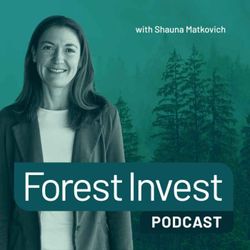
25. Rethinking how we Finance Forest Landscapes with Tony Simons
52:49||Ep. 25Show notesJoin me today, where I speak to Tony Simons, Senior Fellow of UNCCD G20 Initiative and CIFOR/ICRAF. His wealth of experience shines through in this conversation, where he describes the Managalas project, in Papua New Guinea, a country with more than 90% forest cover where 97% of the land is community held. The project truly connects how conservation meets community needs. Though carbon is a piece of the puzzle, Tony explains how valuing such a project on carbon alone is a false representation of the value these forests deliver. We discuss the financing mechanism and multi-stakeholder involvement behind this project and much more. QuotesAnd so the big problem for forest conservation is that forests and forest protection has been equated to carbon and it's so wrong. I mean, we would not allow it or stand for it in any other sector or domain.We want the benefits from forestry at a local level for the communities at a national level in terms of sovereignty and responsibility and at a global level. And we've just hidden those benefits from humanity. And if we really value forests and we think, well, you know, forests were these things created 380 million years ago when CO2 was 4000 parts per million, 10 times what it is today. And it brought down the world's temperature by 10 degrees. Important linksTony Simons LinkedIn: https://www.linkedin.com/in/tony-simons-359b09b/Center for International Forestry Research and World Agroforestry (CIFOR-ICRAF): https://www.cifor-icraf.org/Global Canopy: https://globalcanopy.org/The Managalas Project: https://themanagalasproject.com/Favourite trees: Guaiacum sanctum, Mangifera indica (mango tree), Quercus robur (oak tree)Production teamHost: Shauna Matkovich from The ForestLinkProducer and editor: Magdalena Laas from Unscripted CreativesDetails02:03Overview - Tony's background 05:30Greenwashing evolution12:56Papua New Guinea Managalas Project17:50Financial stakeholders - approvers, enablers, and implementers22:38Fungible value and non-fungible aspects of the project27:08Rules of engagement - corporations and communities33:31Local community trust - carbon markets - partners/funders - revenue stream38:19What's in it for corporates funding the project?43:00Key successes of the project & lessons shared 45:49Importance of land use planning & management49:00Actionable forestry investment adviceSound libraryNature by MaxKoMusic/SoundcloudSopwell Woodlands and Scohaboy Bog SAC, Cloughjordan, Co Tipperary, IRELAND by wild_rumpus/Soundcloud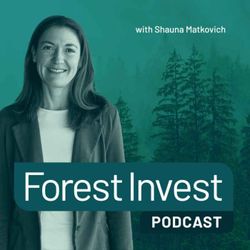
24. The State of Play for Forest Investment in 2024 with Peter D’Anieri
38:54||Ep. 24Show notesJoin me today as Peter D’Anieri of Sewall Forestry walks us through their 2024 Forest Investors Survey results. We discuss discount rates across different US forest investment jurisdictions and beyond to more than 40 other geographic/market-oriented regions. We also talk about the contemporary topics of climate and carbon, interest rates, and much more. This is a must-listen episode if you want to get up to speed quickly on investor sentiment across the asset class.QuoteRecognise that as an investment force, forests are unique because they're a growing asset whose investment attributes are relatively unrelated to, to all other asset classes that people conventionally invest in. Forests are a moderate return risk efficient asset when looked at from an investment perspective, and therefore they deserve to be treated like a core asset in a portfolio.Important linksSewell Forestry: https://www.sewallforestry.com/Favourite tree: Acer saccharum (sugar maple)Production teamHost: Shauna Matkovich from The ForestLinkProducer and editor: Magdalena Laas from Unscripted CreativesDetails01:41Background to Sewell and Peter03:37Investment trends in 2024, e.g., discount rates05:57Discount rate required for traditional timberland in the US06:59Major US regions and regional discount rate differential10:27Factors that can impact discount rates, including carbon agreements12:07Carbon agreements objectives13:20The difference in ESG definitions and questioning on the survey17:07Results re. ESG, sustainability and returns17:57Impact forestry investment themes18:46Surprises in results20:48Climate change risks - concerns from respondents & adjustments23:19Rising interest rate environment26:17Other jurisdictions - appetite for forest investment27:27Expansions - Australia, Chile, US29:08Compressions?31:27Generalisations re. how do these regions compare to the base US discount rate?34:24Question on the survey: do carbon projects reduce the incentives for traditional forestry?35:39Actionable advice36:44Contact detailsSound libraryNature by MaxKoMusic/SoundcloudSopwell Woodlands and Scohaboy Bog SAC, Cloughjordan, Co Tipperary, IRELAND by wild_rumpus/Soundcloud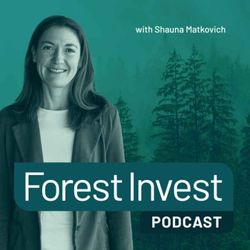
23. Achieving a Quadruple Bottom Line from Indigenous Engagement with Domenico Iannidinardo
22:30||Ep. 23In this week’s episode, I speak with Domenico Iannidinardo, CEO of Strategic Natural Resource Consultants. In this conversation, Domenico and I reminisce about our shared history in a natural resource dependent town and how things have come to change (for the better) with respect to recognition of Indigenous Rights. We talk about how Strategic’s recently new ownership model, majority owned by the Ehattesaht First Nation is giving rise to Indigenous leadership in decision-making, integrating First Nations values in how the business is run and opening up new business opportunities for Strategic."Our Indigenous stakeholders know as much as anyone about perseverance and sustainability; they are the descendants of rich and respected cultures that know how to integrate strategy and vision into everyday decisions. And it takes time." Produced byHost: Shauna Matkovich - The Forest LinkProducer: Magdalena Laas - https://www.linkedin.com/in/laasmagdalena/Important linksStrategic Natural Resource Consultants Inc (SNRC): https://snrc.ca/Favourite tree: Yellow cedarDetails02:19Domenico's background05:08Overview of Strategic Natural Resource Consultants07:48How to integrate Indigenous involvement and advocacy10:19First Nations included at the highest strategic levels11:53Cultural awareness and training12:35Measure cultural line as a corporation13:31Board composition15:40Chief Simon John on native ownership and strategic decision-making17:22Indigenous leadership model18:55Expansion moving forward21:23Actionable advice22:05Contact detailsSound libraryNature by MaxKoMusic/SoundcloudSopwell Woodlands and Scohaboy Bog SAC, Cloughjordan, Co Tipperary, IRELAND by wild_rumpus/Soundcloud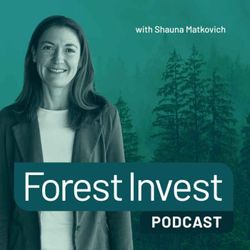
22. The Mindset behind Impact Forestry with MaryKate Bullen and Juan Pablo Lankenau Haas
51:02||Ep. 22In today’s conversation, I’m joined by MaryKate Bullen and Juan Pablo Lankenau of Forest Investment Associates. We discuss FIA’s journey and how the organization’s investing and forest management approach have evolved over the years. Where ensuring sustainable forest management and fiduciary duty remain paramount – the company is finding new ways to bring climate and nature objectives ‘to the front seat’ in what they do. We talk about the mindset shift behind this evolution and the opportunities that are emerging.QuoteJuan Pablo: "This is a very active asset class that requires hands-on work. Our products, which are seedlings, logs, and fertilizer, are very physical, clunky, heavy, and expensive to transport, right? So, making sure to understand all of those dynamics and how they exist in the real world is critical for any newcomer who is thinking about investing in our asset class."MaryKate: "Don't lose sight through the complexity and confusion and the headlines of the real potential that exists with those real assets"Show notesHost: Shauna Matkovich - The Forest LinkProducer: Magdalena Laas - https://www.linkedin.com/in/laasmagdalena/Important linksForest Investment Associates (FIA): https://www.forestinvest.com/Favourite trees: California Redwood & Araucaria araucana (Monkey Puzzle)Register for the Theory of Change Webinar: Theory of Change WebinarDetails03:04FIA's investment and forest management philosophy06:13FIA's business culture08:05FIA's geographical expansion and approach14:29Impact forestry investment - what is it?18:48Aspects of driving the mind-shift towards ESG & responsible investment23:21Forestry and climate change challenge/Sustainable forest management28:35Biases (Juan Pablo)32:35Change in approach to due diligence and supply chain42:33Biases (MaryKate)45:00Success stories47:39Future of FIA50:37Demystify forestry investment51:44Actionable advice54:33Contact detailsSound libraryNature by MaxKoMusic/SoundcloudSopwell Woodlands and Scohaboy Bog SAC, Cloughjordan, Co Tipperary, IRELAND by wild_rumpus/Soundcloud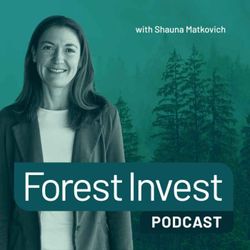
21. How Danish energy company Ørsted is owning NbS with Peter Kristensen
29:56||Ep. 21In today's conversation, I chat with Peter Kristensen, Director, Head of Biomass Sustainability at the Danish energy company, Ørsted. Peter describes Ørsted's transition plan and how they are using nature-based solutions to abate their remaining emissions (only 2%!) after executing their ambitious Science-based targets emission reduction plan. In this conversation, we discuss why Ørsted has targeted the global south for their NbS project development, why they do everything in-house and explains some of the great projects they are supporting. Lots of boots on the ground lessons from this chat!Host: Shauna Matkovich - The ForestLinkProducer: Magdalena LaasQuotes19:05"One thing is sure: if you don't have local partners who are really committed, have the knowledge, and so on, then it is a no-go." 27:29"I would encourage people to ensure the financing that they need before they start knocking on doors. Otherwise, we'll jeopardise this whole carbon market project; I don't think anyone will benefit."Important LinksPeter Kristensen LinkedIn: https://www.linkedin.com/in/peter-k-kristensen-gcb-d-106a32/Ørsted: https://orsted.com/Favourite trees: Oak and Scots PineDetails00:58Intro to Ørsted02:55Ørsted's nature-based solutions - science-based targets (reduce emissions) & carbon projects04:24Why Global South05:32Projects09:51Design and execution standards11:22Internal and external contributors13:01Local community participation, agreement, and remuneration15:04Using, selling. retiring carbon credits16:33Run daily business and operations (system evaluation)18:01Learning curve with each project19:57Evaluate a local partner21:00Government support/legislation21:47Exit strategy24:00Extra benefits - education24:40Next steps (target of 2%)26:26Must ensure financing - actionable advice29.27Contact detailsSound LibraryNature by MaxKoMusic/SoundcloudSopwell Woodlands and Scohaboy Bog SAC, Cloughjordan, Co Tipperary, IRELAND by wild_rumpus/Soundcloud
20. Technical considerations for evaluating forest assets with Dr. Colin Smith
46:48||Ep. 20In today's episode we dig into all things technical site evaluation with Dr. Colin Smith of Paperbark Consulting. Colin is an expert soil scientist, and today he shares his vast experience in plantation forestry, giving insights that will support investors (and forest managers for that matter) with what considerations should be made and questions should be asked when evaluating several technical plantation management factors. We talk about where certain tree species do best and get into specifics on soil, water, climate, the importance of research, ecological deserts and more.Quotes:4:16"The most dangerous thing in a forestry investment plan is a spreadsheet"43:37"Make sure they get a good independent opinion about what they're up to. In some cases, consultants try to make projects look good to attract investment, and I think there is a big danger in that; not to be seen as a wet blanket, but I think people need a realistic appraisal."Show notes:Host: Shauna Matkovich - The Forest LinkProducer: Magdalena Laas - https://www.linkedin.com/in/laasmagdalena/Important links:Dr. Colin Smith's email: cs.paperbark@gmail.comLinkedin: linkedin.com/in/colin-smith-900b051aFavourite trees: Acacia Sieberiana and Eucalyptus degluptaThe Center for International Forestry Research and World Agroforestry (CIFOR-ICRAF): CIFORTheory of Change Webinar: Theory of Change WebinarDetails:00:44Professional background and focus of work (Paperbark Consultancy)04:09The complicated process of forest management05:54Interesting assignments (real stories)09:05Macro-level technical considerations when investing in forestry13:08Micro-level technical considerations15:41Issues with native species17:56Dispell myths around Eucalyptus, specifically water usage23:30Irrigation of plantations30:59Climate change & species matching36:25Invest in research and technical expertise39:03Info on sustainability studies - eucalyptus & PH levels of soil (CIFOR)43:36Actionable advice for forestry investors44:46Contact detailsSound Library:Nature by MaxKoMusic/SoundcloudSopwell Woodlands and Scohaboy Bog SAC, Cloughjordan, Co Tipperary, IRELAND by wild_rumpus/Soundcloud
19. The Difference between ESG, Sustainable and Impact Investing in the Context of Forests
16:35||Ep. 19As there are no widely accepted definitions in the lexicon that makes up responsible investing, semantics are important. This is because how you define terms like ESG, sustainable and impact investing as they relate to forest investments will have different implications - it could be in the types of forests you invest, the geographies of your investment, the end markets, return expectations and so on. In this episode, I take you through the definitions of these terms that I apply in my work and provide you some examples to make sense of it. I argue that its not the definition per se that matters, only that everyone in your organization shares the same definition and that you apply it credibly and consistently. I explain why an integrated approach to ESG, sustainable and impact investing will put your forest investments in the best position to succeed."Integrating these three features is the best way to future-proof your forest investments for financial performance and long-term social and environmental benefit."Show notes:Host: Shauna Matkovich - The Forest LinkProducer: Magdalena Laas - https://www.linkedin.com/in/laasmagdalena/Important links:Webinar: Theory of Change Webinar (subscribepage.io)Favourite tree: Arbutus menziesii - WikipediaDetails:02:47 ESG investing05:01 Sustainable investing07:02 Impact investing11:09 Integrated approach14:12 How to apply an integrated approach15:15 Webinar15:37 Actionable advice for forest investors Sound Library:Nature by MaxKoMusic/SoundcloudSopwell Woodlands and Scohaboy Bog SAC, Cloughjordan, Co Tipperary, IRELAND by wild_rumpus/Soundcloud
17. Achieving Impact and Sustainable Forest Businesses in Emerging Markets with Anne Valto
31:03||Ep. 17Join me today in the second of a two-part series, as I speak with Anne Valto, Senior Development Impact Advisor at Finnfund - the Finnish Development Finance Institution. In our conversation, Anne describes how Finnfund evaluates impact in deal due diligence. She explains how often their investees are not initially well capacitated to manage for impact, and how they are supporting to resolve this. We talk about why Finnfund normally does not invest into 3rd party managed, forest asset only models, finding the balance between impact and financial objectives and impact permanence at exit. If you haven’t listened to the first episode, please go back and listen to my conversation with Peter Chappell on breaking down risks in emerging markets. “In forestry and in biodiversity, as in most impact indicators, the high risk usually means that there are more opportunities to gain as well.”Show notes:Host: Shauna Matkovich - The Forest Link Producer: Magdalena Laas - https://www.linkedin.com/in/laasmagdalena/Details 03:39Impact evaluation in deal due diligence and the 5 dimensions of impact05:00Development Effectiveness Assessment Tool06:21How Finnfund goes beyond IFS PS to evaluate net biodiversity gain07:51How Finnfund supports traditional timberland managers to integrate impact11:38Biodiversity trainings for investees11:52Biodiversity pilot with MLR in Nicaragua13:20Sustainability capacity within Finnfund investee companies14:29Why Finnfund normally does not invest into 3rd party managed, forest asset only models16:50Finding the balance between impact and financial objectives19:19Does targeting impact mean forgoing returns?23:40Low hanging fruit for impact creation in forest investments26:01Impact permanence at exit30:11Actionable advice for investors new to the asset classSignificant quotes:[5:50] In forestry and in biodiversity, as in most impact indicators, the high risk usually means that there are more opportunities to gain as well.[17:42] So that's our role, taking more risks than, than a commercial investor would be willing to, to take.[25:02] It's often that you actually don't need to do that much to give a little bit of push for regeneration and restoration. In the environments where we operate, the more challenging part is then to also keep people out.[28:01] So if we would totally lose the impact for big money as an impact investor, I think that would be quite a red flag for us.Links mentioned:Finnfund: https://www.finnfund.fi/en/MLR Forestal: https://mlr.com.ni/ Sound Library:Nature by MaxKoMusic/SoundcloudSopwell Woodlands and Scohaboy Bog SAC, Cloughjordan, Co Tipperary, IRELAND by wild_rumpus/Soundcloud